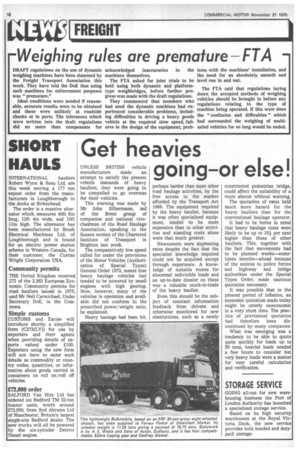Get heavies going-or else!
Page 20

If you've noticed an error in this article please click here to report it so we can fix it.
UNLESS BRITISH vehicle manufacturers made an attempt to satisfy the present vehicle demands of heavy hauliers, they were going to be compelled to go overseas for their vehicles.
This warning was made by Mr John Silbermann, md of the Brent group of companies and national vicechairman of the Road Haulage Association, speaking to the Sussex section of the Chartered Institute of Transport in Brighton last week.
The comparatively low speed called for under the provisions of the Motor Vehicles (Authorisation of Special Types) General Order 1973, meant that heavy haulage vehicles had tended to be powered by small engines with high gearing. Now, however, many of the vehicles in operation and available did not conform to the prescribed power/weight ratio, he explained.
Heavy haulage had been hit, perhaps harder than most other road haulage activities, by the free access to the market afforded by the Transport Act 1968. The equipment required by the heavy haulier, because it was often specialised equipment, tended to be more expensive than in other activities and standing costs alone were that much greater.
Newcomers were depressing rates despite the fact that the specialist knowledge required could not be acquired except through experience. A knowledge of suitable routes for abnormal indivisible loads and an up-to-date dossier on these was • a valuable stock-in-trade of the heavy haulier.
Even this should be the subject of constant information feedback from drivers and otherwise monitored for new obstructions, such as a newly constructed pedestrian bridge, could affect the suitability of a route almost without warning.
The quotation of rates held much more hazard for the heavy hauliers than for the conventional haulage operator.
It had to be borne in mind that heavy haulage costs were likely to be up to 33i per cent higher than those of other hauliers. This, together with the fact that movements had to be planned weeks—some. times months—ahead because of the notices to police forces and highway and bridge authorities under the Special Types Order, made cautious quotation necessary.
It was possible that in the present period of inflation, an economic quotation made today might be utterly uneconomic in a very short time. The practice of provisional quotation had therefore been discontinued by many companies.
What was emerging was a tendency to be able to quote quite quickly for loads up to 50 tons, heavier loads needed a few hours to consider but very heavy loads were a matter for very careful calculation and verification.








































































































